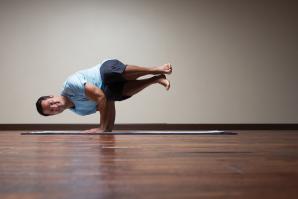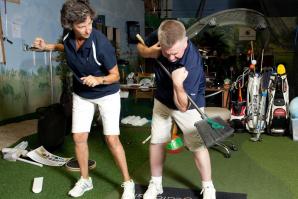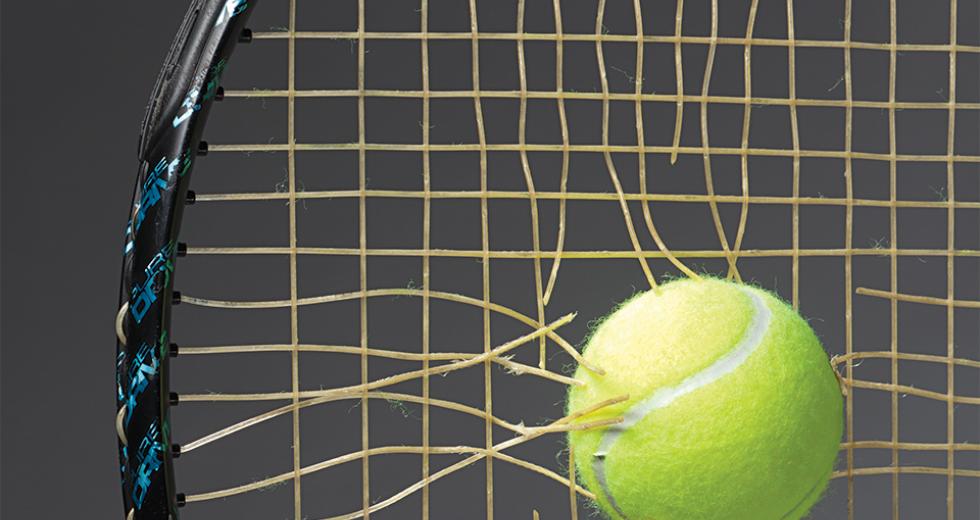It started with a girl. She had played tennis in college. Desperate to impress her, I challenged her to a match. Sure, I had never played, but I could hold my own. I’m a guy. I jog. We took to the court, she tapped me a gentle forehand and I swung into nothing but air. Then I whiffed again. Finally, I made contact — and smacked the ball over a chain-link fence.
That afternoon, I lost the match and my dignity, but I gained a love of tennis — nay, an obsession. I signed up for classes, I practiced against a wall, I woke up at 3 a.m. to watch the Australian Open and I trolled public courts to meet fellow beginners.
At 37, I’m late to the game, only now discovering a secret that much of Sacramento already knows: Tennis is more than recreation; it’s a super-sport that fuels our bodies and our brains, bestowing all kinds of surprising benefits. And while tennis is an afterthought for much of the United States, in the Capital Region, at least, the sport is booming.
“If you looked at tennis in Sacramento 20 years ago, it was a dead town. Now, the Central Valley has exploded,” says Vitaly Gorin, owner of Gorin Tennis Academy and one-time coach of Dmitry Tursunov (ranked No. 32 in the world as of April). “There are an enormous number of courts here. So many courts, so many clubs. If you build it, they will come. It’s easy to find a court and easy to find a partner.” And the year-round sunshine doesn’t hurt.
For me, there’s more to it than the game. There is also the rejuvenating — and rare — experience of picking up a new sport. We humans tend to narrow our interests as we age. When we’re kids, we gobble up new hobbies and hurl ourselves into new pursuits, but by the time we graduate college, most of us have settled on our chosen activities, our musical instruments, our favorite teams. We either play the piano or we don’t. Our hobbies then dwindle, and we swap them for careers, spouses and kids. Rarely do we add interests to the mix. Tennis, for me, has become more than a sport; it’s a promise to myself: I will not grow complacent. I will not calcify. I am not a finished product.
I found a kindred spirit in Ben Combs, owner of a dry-cleaning business (Judi’s Cleaners) with locations in Fair Oaks and Carmichael. Combs had played briefly in high school, but by the time he turned 32 hadn’t touched a racquet in more than a decade. For their 10-year anniversary, his wife surprised him with tickets to a tennis “vacation” and dragged him to a lesson. He wanted nothing to do with it. “I was pretty disappointed I had to go,” admits Combs, laughing.
He grudgingly went to that first lesson — and never stopped. “I took a lesson every week from age 32 to 42,” says Combs, and after years of relentless practice, he went from being a “chump of a player” to winning local tournaments. He installed a clay court in his backyard. The United States Tennis Association uses a 7-point scale to rank players. A newbie like me starts at a 1.0, Roger Federer is a 7.0 and Combs peaked at an elite 5.5. Just how far did he get? From 2003 to 2007, he was a part-owner of the Sacramento Capitals professional tennis team. Combs is living proof: It can be done.
THE SUPER SPORT
Of course tennis is good for you. Everyone knows that. But it might just be exceptionally good for you — better than jogging, weight-lifting, cycling and certainly better than golf. “While other sports can provide excellent health benefits and some can promote mental and emotional growth, none can compete with tennis in delivering overall physical, mental and emotional gains,” writes Jack Groppel, former chairman of the USTA’s National Sport Science Committee.
Tennis, for me, has become more than a sport; it’s a promise to myself: I will not grow complacent. I will not calcify. I am not a finished product.
Tennis is a game of starts and stops, bursts of energy and then a few beats of recovery. Long before the term became fashionable, tennis provided the secret ingredient of total fitness: interval training. New research suggests this type of high-intensity training — 30 seconds of gut-busting sprinting, followed by a few minutes of light jogging, followed by 30 seconds of sprinting, ad nauseam — is more effective at burning fat. Since the typical tennis match contains 300 to 500 bursts of energy, you are interval training without even knowing it.
It’s also a sport you can play until they put you in a wheelchair, and even then you’ve got options. “Our slogan is ‘Tennis for Life,’ and that’s not just a jingle,” says Carol Rose, who is in her sixties and plays three to four times a week as president of the Sacramento Area Tennis Association. “I know people who play into their 80s; they learn to play the ball where you are not,” she says of the seniors’ strategy.
And these 80-year-olds continue to reap the benefits. Tennis boosts bone density (useful in fighting osteoporosis), lowers cholesterol and improves our body’s dynamic balance. Think about a tennis swing. Unlike golf, where you whack a ball while standing still, tennis requires swinging on the run. Over time, that motion improves core stability and coordination, making you less likely to fall as you age. That’s not trivial. For seniors, falls are a leading cause of hospitalization and the single biggest driver of hip fractures, which can lead to dramatically higher mortality rates. Takeaway: Tennis can literally save your life.
One of these seniors, Gerard, met me on a public court. He had a quick smile and wore knee pads, elbow pads, thick glasses, and it looked like he could be knocked over by a stiff wind. But I didn’t stand a chance. He played a safe, reliable game that ran me off the court. The score wasn’t close, and I could tell that he was holding back on me. A geriatric was holding back on me.
I continued to get my butt kicked as I took more classes and met more players, but I also felt sharper, more focused. This might just be my own delusions, but it’s also possible that tennis is good for your brain. “A fast-paced workout such as tennis improves the production and release of brain-boosting proteins and increases the production of cells in the brain’s hippocampus, which is where learning and memory function takes place,” writes Groppel in the 2009 study “Tennis, for the Health of It.” “Because tennis requires alertness and tactical thinking, it may generate new connections between nerves in the brain and promote a lifetime of continuing brain development.”
Neuroscience aside, tennis is also a good way to meet people. “It’s incredibly social, says Cris Bacharach, tennis director at Johnson Ranch Racquet Club in Granite Bay, who hosts wine-and-cheese events like “twilight tennis” socials. It can be difficult as an adult to meet new friends, and tennis is an easy ice-breaker.
And while golf is known as the ultimate networking sport, tennis can also fill that niche. “I do business with the people that I play with, because I get to see what they’re like on the court,” Combs says. “If they’re going to cheat you on the court, then you know you don’t want to do business with them.”
The sneakiest benefit of tennis, though, might be something that’s harder to pin down: focus. “Tennis can be a life-changer,” Bacharach says. “It can give you focus for why you’re in the gym. I hate working out, but when I got into my 40s, I focused on the upper body and the core, and this helped with my serve and racquet-speed. I felt so much better on the court.” Tennis has a “spillover” effect in that it triggers other healthy habits, and it’s the only reason that Combs bothers to hit the gym.
I can relate. Not only has it changed my approach to exercise, tennis has even changed the way I view aging. Like most people in their 30s, I had a dread of turning 40. Not anymore. Instead, I’m doing the math, and I’ve calculated that if I keep improving, by the time I turn 39 I’ll be a 3.5 player, and by the time I’m 40, with luck, I’ll be rated 4.0. This is a new life goal: 4.0 by 40.
Is it possible?
“Tennis has a high attrition rate,” admits Gorin. “Unlike a lot of sports, it’s very technical. It takes some time before you get good.”
I’m beginning to find that out. Tennis has a way of calling out your strengths and weaknesses. “Relax. You need to relax,” coach after coach has told me. Okay, but how? I’m a walking mass of anxiety. My entire life, I’ve found that the command, “You need to relax” is about as effective as telling a blind person, “You just need to see!”
After taking several classes, I became frustrated that I didn’t see much improvement. I still sprayed forehands all over the court. I still served into the net. To get a condensed version of the coaching you might find at a club like Johnson Ranch, I spent a long weekend at a retreat called Total Tennis. This wasn’t some glitzy resort. The accommodations were like woodsy college dorms: twin beds, shared bathrooms and a cafeteria heavy on breaded cheese. We woke up each morning at 7, hit the courts by 8:30 and ran drills until sunset.
Finally, after the repetition of hundreds of thousands of strokes, I started to feel a difference in my swing. It felt smoother, less jerky. My serves were routinely landing in the service box, and sometimes they even had some oomph. Finally.
Two days later, when I returned home to play a friend, I stunk. It seemed that everything I had learned was fleeting. I kept double faulting and was soon shanking every ball in sight. My confidence plummeted. As I doubted my swing, I doubted my ability to do anything. It can be a vicious cycle.
I spoke with Todd Dilbeck, a Sacramento-based sports psychologist who confirmed what I suspected — I’m getting into my own head. “The trap that some people run into is focusing on the win. You need to keep your focus on the task, on the development.” Fair enough. When you are competitive, you want to win — regardless of your lack of skill. I’m learning that tennis builds patience. Slooooowly. It takes time, it takes humility and it takes a long-term perspective. But that’s okay: Tennis is for life.
And as for the girl who introduced me to tennis? In the Hollywood version of this story, we got married at the US Open. In reality, we soon broke up and I’m still double faulting. I’m still playing against the 70-something. The last time we played he sprinted out to a 5-0 lead, but then I dug in, found a rhythm and came back to tie the set at 5-5. I took a brief lead and even served for set point, but in the end, we tied at 6-6 before getting booted off the public court.
That was my Rocky moment. That was the triumphant end to my first season playing tennis: a tied set with a man old enough to be my grandfather.
It’s a start.
Recommended For You

Hurts So Good
Yoga is good for you, but be careful boys
I’ve always snickered at yoga.It just seemed ridiculous. But men are flocking to yoga the way we once, in the ’80s, took to this thing called “jogging.” We’re learning that yoga bestows a slew of health benefits — physical, mental, even sexual. But new research also points to increased health risks for men, and this muddies the decision.

Getting the Swing of It
A new resource for the ailing golfer
When you literally don’t have a good leg to stand on, golf can be particularly frustrating — especially if you’re an aging weekend whacker with physical ailments and a set of custom irons that weren’t customized for you.
Recently, that’s my predicament.



